If the so called Rothenthurm-Inititative had not been adopted, many of the Swiss mires would today be irretrievably lost. Thanks to mire protection only 1 percent of these areas of national importance have been lost during a survey period of 5 years. The quality of the mires however has degenerated. Regeneration and a reduction in nutrient contamination should improve the situation.
Mires make up only 0.5 percent of Switzerland’s land area, but they are home to around a quarter of the endangered plant species. The adoption of the Rothenthurm-Initiative on 6th December 1987 triggered off a considerable improvement in the protection of Swiss mires and biotopes. Today the mires (bogs as well as fens) and mire landscapes of national importance are registered in relevant state inventories.
In time for the 20th anniversary of the adoption of the Rothenthurm-Initiative the Federal Office for the Environment (BAFU) has published the results of the performance review on mire protection, which it has been carrying out since 1997. The performance review provides, for the first time, scientifically supported information about the condition and development of the mires and mire landscapes of national importance. These observations stretch back over 10 years. Every location was controlled twice within these ten years at five year intervals.
What is a mire?
Mires can develop everywhere where the soil is saturated with water: along waterways, in areas with damp cool climates, over beds of clay or loam and around springs. Only specialized plant species such as the sundew can colonize the soil and live in the air both of which are usually low in oxygen. The extreme environmental conditions of the soil lead to the fact that plant remains do not completely decompose. They pile up and form peat. Depending on the evolutionary history of a mire, its relation to the groundwater, its surface form, the nutrient content of the water and type of vegetation we are able to discern between raised bogs and fens.
Raised bog
In wet locations with sufficient precipitation and moderate temperatures a raised bog develops. The yearly growth of peat in the central European bogs is 0.5 to 1.5 millimetres. The layer of living plants is constantly being pushed upwards so that the plants loose contact with the ground water. The bevelled bog resembles a huge sponge. In the primeval landscape of central Europe the bogs were one of the few locations below the timber line which were forest free (Fig. 1).
Fen
Contrary to raised bogs, fens are not kept wet by precipitation alone, but also by groundwater, slope water, or temporary flooding. Because of this fens contain more nutrients than bogs. In the primeval landscape fens developed along the banks of rivers and silted lakes. Above the timber line they covered all wet areas. Today, the majority of fens are cultivated biotopes which have developed on cleared but not totally drained land (Fig. 2).
Successful quantitative protection, but qualitative degeneration
Today 91 percent of raised bogs and 87 percent of fens are protected by the cantons. The protection of 85 percent of mire landscapes has been implemented or is well underway. Therefore an important first step has been taken towards protection. Thanks to this protection only 1 percent of bogs and fens of national interest has been lost.
However, the quality of the protected mires has degenerated considerably within these ten years. Their actual state is as follows: over one quarter of the mires has become drier, in one quarter the nutrient contamination has increased and nearly one third of locations are affected by shrub or forest encroachment, because the biotopes are no longer used or have dried out.
Protection of valuable habitats
With the adoption of the Rothenthurm-Initiative the Swiss voters chose to protect the remaining Swiss mires and mire landscapes. 200 years ago mires covered 6% of the total land area of Switzerland. At the time of the Rothenthurm-Initiative on 6th December 1987 it was only around 0.5% (Fig. 3). Peat mining and drainage were the principal reasons for this reduction. Only by placing the mires under protection was it possible to stop their direct destruction (Fig. 4).
Mires are important habitats. Raised bogs belong to the last remains of the Swiss primeval landscape; fens are living witnesses of the traditional cultural landscapes. Mires therefore contribute directly to the quality of the landscape. They are of key importance for the biodiversity: a quarter of all endangered plant species in Switzerland grow on only 0.5 % of its land area. Intact mires are also important carbon sinks.
Regenerate mires and encourage cooperation
To combat the drying out and encroachment the BAFU wants to put an emphasis on regeneration. Regeneration measures could stop the drainage of the mires. By closing up old drainage ditches and pipes the original hydrology could be re-established. (Fig. 5). The regeneration process could take many decades but the performance review has proved that bogs are able to re-grow after regeneration.
To solve the problem of nutrient contamination in the mires – especially in the fens – there must be cooperation with the agricultural sector. The nutrient contamination can be prevented by the establishment of a wide enough puffer zone.
The most important partners of the BAFU are the Cantons. They are responsible for the implementation and execution of mire protection measures.
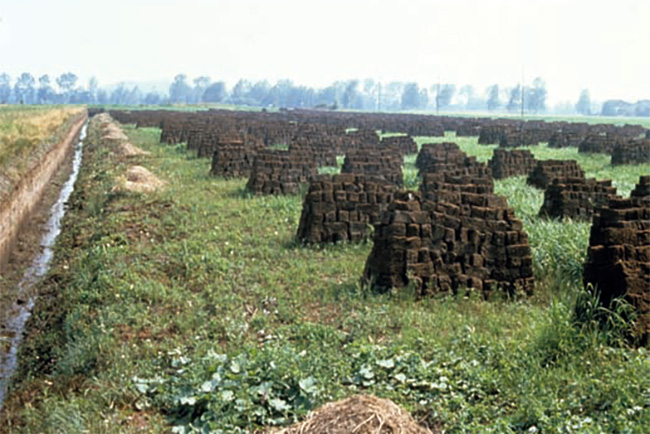
Fig. 4 - Peat turfs were cut in Swiss bogs well into the 1980’s. Photo: Hintermann & Weber
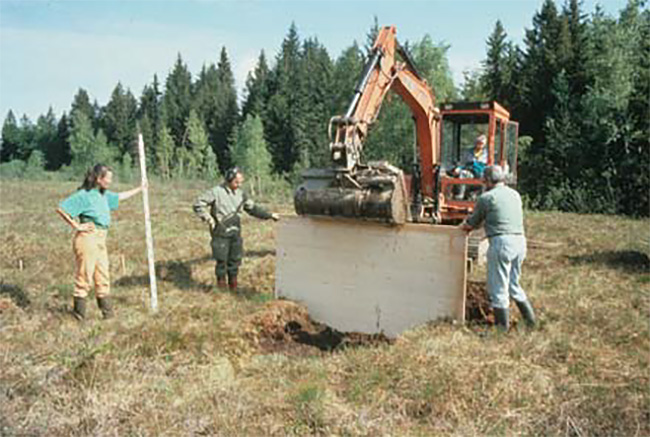
Fig. 5 - Driving in wooden boards is an effective way of closing drainage ditches. Photo: Philippe Grosvernier
Translation: Dawn Meister, Stallikon


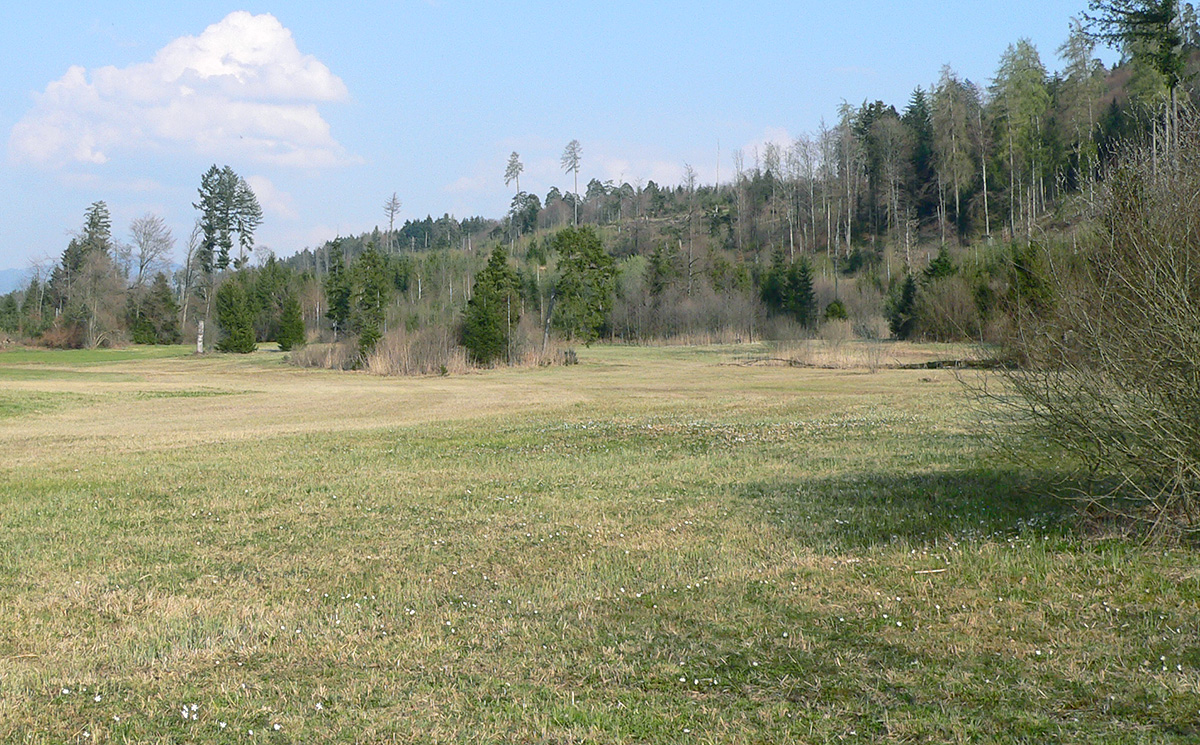
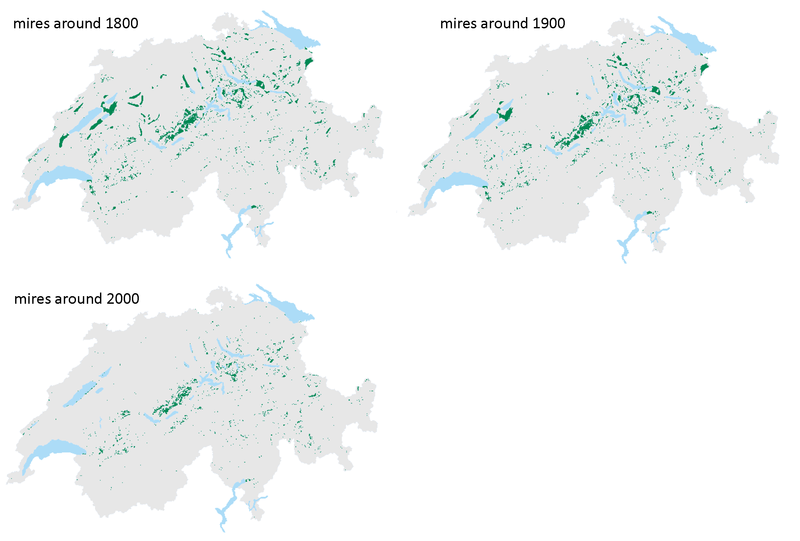
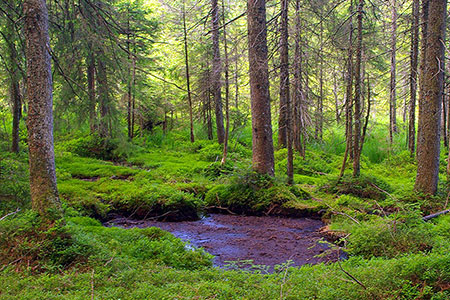

![[Translate to English:] [Translate to English:]](/assets/wald/naturschutz/gewaesser/fva_wasserhandbuch_kartographische_erfassung_waldbewirtschaftung/fva_wasserhandbuch_kartographische_erfassung_gewaesser_auswirkungen_waldbewirtschaftung_abb1.jpeg)